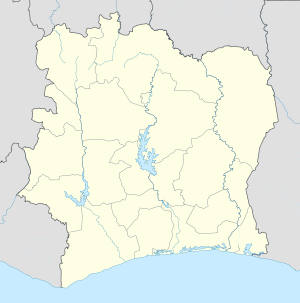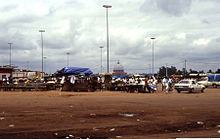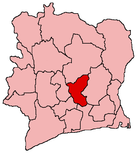- Yamoussoukro
-
Yamoussoukro Location within Côte d'Ivoire Coordinates: 06°49′00″N 05°17′00″W / 6.8166667°N 5.2833333°WCoordinates: 06°49′00″N 05°17′00″W / 6.8166667°N 5.2833333°W Country  Côte d'Ivoire
Côte d'IvoireRegion Lacs Department Yamoussoukro Government – Governor Augustin Abdoulaye Thiam Houphouët Augustin Abdoulaye Thiam Houphouët Area – Total 3,500 km2 (1,350 sq mi) Population (2005) – Total 200,659 – Density 148.5/km2 (384.6/sq mi) Time zone UTC The District of Yamoussoukro /ˌjɑːməˈsuːkroʊ/ is the official political capital and administrative capital city of Côte d'Ivoire, while the economic capital of the country is Abidjan. As of 2010, it was estimated to have 242,744 inhabitants. and located 240 kilometres (150 mi) north-west of Abidjan, the administrative center on the coast, upon rolling hills and plains, the municipality covers 3,500 square kilometres (1,400 sq mi) and is coterminous with the department of the same name. The department and municipality are split into four sub-prefectures: Attiégouakro, Didiévi, Tié-diékro and the Commune of Yamoussoukro. In total, the district contains 169 settlements.
In 1998, the city had about 155,803 inhabitants. It is the fourth most populous city in Côte d'Ivoire, after Abidjan, Bouaké, and Daloa.
The current governor of the district is N'Dri Koffi Apollinaire.
Yamoussoukro is actually pronounced "Yam-So-Kro" by all Ivorians, which is the correct way to pronounce it. Sometimes it's possible to hear "Ya-Mu-So-Kro" but in any case, the second "U" is silent.[citation needed]
Contents
History
Colonial period
Queen Yamousso, the niece of Kouassi N'Go, ran the village of N'Gokro in 1901 at the time of French colonization. The village then comprised 475 inhabitants, and was one of 129 Akoué villages.[citation needed]
Diplomatic and commercial relations were then established, but in 1909, on the orders of the Chief of Djamlabo, the Akoué revolted against the administration. Bonzi station, 7 kilometres (4.3 mi) from Yamoussoukro on the Bouaflé road, was set on fire, and the French administrator, Simon Maurice, was spared only by the intervention of Kouassi N'Go. This respected former leader persuaded the Akoué not to wage a war which could only have turned into a disaster.[citation needed]
As the situation returned to normal, Simon Maurice, judging that Bonzi had become unsafe, decided to transfer the French military station to Yamoussoukro, where the French Administration built a pyramid to the memory of Kouassi N'Go, Chief of the Akoué. In homage to queen Yamousso, N'Gokro was renamed Yamoussoukro.[citation needed]
In 1919, the civil station of Yamoussoukro was removed. Félix Houphouët-Boigny became the leader of the village in 1939. A long period passed wherein Yamoussoukro, still a small agricultural town, remained in the shadows. This continued until after the Second World War, which saw the creation of the African Agricultural Trade Union, as well as the first conferences of its chief. However, it was only with independence that Yamoussoukro finally started to rise.[citation needed]
Since independence
After 1964, the President Félix Houphouët-Boigny made ambitious plans and started to build. One day in 1965, later called the Great Lesson of Yamoussoukro, he visited the plantations with the leaders of the county, inviting them to transpose to their own villages the efforts and agricultural achievements of the region. On 21 July 1977, Houphouët offered his plantations to the State.
In March 1983, President Félix Houphouët-Boigny made Yamoussoukro the political and administrative capital of Côte d'Ivoire, as the city was his birthplace. This marked the fourth movement of the country's capital city in a century. Côte d'Ivoire's previous capital cities were Grand-Bassam (1893), Bingerville (1900), and Abidjan (1933). The majority of economic activity still takes place in Abidjan.
Highlights
Yamoussoukro is also the site of what is claimed to be the largest Christian place of worship on Earth: The Basilica of Our Lady of Peace of Yamoussoukro, consecrated by Pope John Paul II on 10 September 1990.
Also noteworthy are the Kossou Dam, the Félix Houphouët-Boigny Foundation, the PDCI-RDA House, the various schools of the Félix-Houphouët-Boigny Polytechnic Institute, the international airport (with an average of six hundred passengers and 36 flights in 1995, it is one of two airports in Africa (with Gbadolite) that could accommodate the Concorde), the Town Hall, the Protestant Temple, the Mosque, and the Palace of Hosts.
On 6 November 2004, Yamoussoukro Airport was attacked by French infantry after military aircraft from the airport bombed a UN peacekeeper base as well as rebel targets, 9 French peacekeepers and one U.S. civilian were killed. Two Ivory Coast Sukhoi Su-25 aircraft and several Mil Mi-24 helicopters were destroyed, which was most of the country's air forces. Mobs and rebels tried to attack the French forces after the airport raid.
On 30 March 2011, the city of Yamoussoukro fell to forces led by the democratically elected Alassane Ouattara, who had been recognized internationally as the legitimate president of Côte d'Ivoire.[1]
References
- ^ Nossiter, Adam (30 March 2011). Opposition Forces in Ivory Coast Make Major Gains. New York Times, 30 March 2011. "A version of this article appeared in print on 31 March 2011, on page A6 of the New York edition." Retrieved from http://www.nytimes.com/2011/03/31/world/africa/31ivory.html.
External links
 Departments of Côte d'Ivoire
Departments of Côte d'IvoireAbengourou · Abidjan · Aboisso · Adiaké · Adzopé · Agboville · Agnibilékrou · Akoupé · Alépé · Bangolo · Bocanda · Béoumi · Bettié · Biankouma · Bloléquin · Bondoukou · Bongouanou · Botro · Bouaflé · Bouaké · Bouna · Boundiali · Dabakala · Dabou · Daloa · Danané · Daoukro · Didiévi · Dimbokro · Divo · Duékoué · Ferkessédougou · Fresco · Gagnoa · Grand-Bassam · Grand-Lahou · Guéyo · Guiglo · Guiglo · Issia · Jacqueville · Katiola · Korhogo · Koro · Kouibly · Koun-Fao · Kounahiri · Kouto · Lakota · Madinani · Man · Mankono · Mbahiakro · Minignan · Nassian · Odienné · Ouangolodougou · Oumé · Prikro · Sakassou · San Pédro · Sassandra · Séguéla · Sikensi · Sinématiali · Sinfra · Soubré · Tabou · Tanda · Tiapoum · Tiébissou · Tingréla · Tiassalé · Touba · Toulépleu · Toumodi · Vavoua · Yakassé-Attobrou · Yamoussoukro · Zuénoula · Zouan-Hounien · Zoukougbeu
Capitals of Africa Abuja, Nigeria
Accra, Ghana
Addis Ababa, Ethiopia
Algiers, Algeria
Antananarivo, Madagascar
Asmara, Eritrea
Bamako, Mali
Bangui, Central African Republic
Banjul, Gambia
Bissau, Guinea-Bissau
Bloemfontein, South Africa 1
Brazzaville, Rep. of the Congo
Bujumbura, Burundi
Cairo, Egypt
Cape Town, South Africa 2
Conakry, GuineaPort Louis, Mauritius
Porto-Novo, Benin
Praia, Cape Verde
Pretoria, South Africa 3
Rabat, Morocco
Saint-Denis, Réunion
São Tomé, São Tomé and Príncipe
Tripoli, Libya
Tunis, Tunisia
Victoria, Seychelles
Windhoek, Namibia
Yaoundé, Cameroon
Yamoussoukro, Côte d'Ivoire1 Judicial. 2 Parliamentary. 3 Executive. 4 An unrecognised or partially-recognised state. Communes and towns of the Lacs RegionCapital:Yamoussoukro
Communes and towns of the Lacs RegionCapital:YamoussoukroDidiévi Department Tiébissou Department Tiébissou · Ahougnanssou · Ahougnassou-Alahou · Lomokankro · Molonou · N’Gattadolikro · Pranouan · Yakpabo-SakassouToumodi Department Yamoussoukro Department Categories:- Capitals in Africa
- Populated places in Lacs Region
- Yamoussoukro
- Communes of Côte d'Ivoire
Wikimedia Foundation. 2010.




